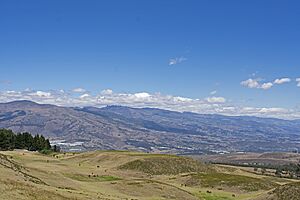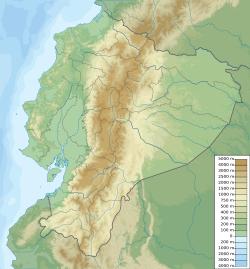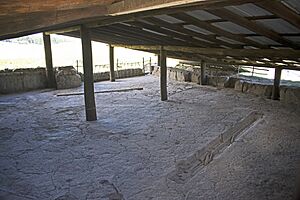Cochasquí facts for kids

Pyramid 5 seen from the northwest
|
|
| Location | Ecuador |
|---|---|
| Coordinates | 00°03′24″N 78°18′37″W / 0.05667°N 78.31028°W |
| Type | Settlement |
| History | |
| Founded | c. 950-1530 CE |
| Site notes | |
| Condition | In ruins |
Cochasquí is one of the largest and most important ancient sites in northern Ecuador. It holds many ruins from before the Inca Empire took over. This special place is about 30 kilometers (19 miles) northeast of Quito. It sits high in the mountains, about 3,040 meters (9,970 feet) above sea level.
The Cochasquí archaeological park covers a large area of 84 hectares (208 acres). You can find 15 pyramids with flat tops and 21 burial mounds here. These mounds are known locally as tolas. The site also has a few small museums. There's an archaeological museum, two museums about local cultures, a botanical garden, and a museum with old musical instruments. The huge Mojanda volcano, which is 4,263 meters (13,986 feet) tall, stands tall over the site.
Contents
What is Cochasquí?
The pyramids and other structures at Cochasquí were built a long time ago. Construction happened between 950 CE and the 1530s, when the Spanish arrived. Archaeologists believe the Quitu-Cara culture or the Caranqui people built them. These two groups might have been the same people.
Before the Incas conquered the area in the late 1400s, northern Ecuador had many small kingdoms. These kingdoms were made up of people who shared similar languages and ways of life. The Cayambe kingdom might have controlled the Cochasquí area when the Incas first arrived.
The Pyramids and Mounds
There are 15 pyramids at Cochasquí. Nine of them have long ramps leading up, and six do not. The biggest pyramid is number nine. It is 90 meters (295 feet) long from north to south and 80 meters (262 feet) wide from east to west. This pyramid stands 21 meters (69 feet) high. Its ramp is very long, stretching about 200 meters (656 feet).
The main material used to build these pyramids is a soft volcanic stone called cangahua. This stone can wear away easily. However, the pyramids have survived because they became covered with grass over time.
What was Cochasquí used for?
Archaeologists think Cochasquí was a special place for ceremonies and studying the stars. It was likely used to figure out the best times for planting crops. This was done by observing the sun's position during solstices. Leaders and important people might have lived on top of the flat pyramids. The site also likely had military and political importance. The tolas were used as burial places, as many ancient skeletons have been found there.
Experts believe that the ancient community of Cochasquí, including its farms, supported about 3,000 people.
Why is Cochasquí Important?
The Inca attack on Cochasquí probably started around the same time the Incas won a long fight at the Pambamarca Fortress Complex. Pambamarca is about 15 kilometers (9 miles) to the southeast. One expert believes Pambamarca fell to the Incas around 1505.
Cochasquí has become a very important symbol in Ecuador's history. There is a famous legend about the Inca conquest of Cochasquí. It tells the story of Quilago, the Queen of Cochasquí, and the Inca Emperor, Huayna Capac. The legend says that for two years, the Incas could not defeat Quilago's armies. Eventually, Quilago was captured and had to marry Huayna Capac. Some stories even say that their child was the future emperor Atahualpa.
The legend continues that Quilago tried to trick and kill Huayna Capac in her room. But her servants told on her, and she was executed. After Quilago's defeat, the Incas were able to conquer more of northern Ecuador. They defeated the Caranqui people in a big battle at Yawarkucha.
This legend is very important in Ecuador. A Spanish writer in 1613 described a play in Quito that showed the fight between the Inca invaders and Cochasquí. It also showed the relationship between the Inca Emperor and the brave warrior queen. The legend helps explain Ecuador's national story. It shows a mix of the conquering Incas and the local Ecuadorian people who fought against foreign rule. They first fought the Incas, and later the Spanish.
Today, Cochasquí is still a special place for many people. It is used for ceremonies, traditional dances, and shamanistic rituals. People also hold marriages there. These events help people connect with the history and ancestors of modern-day Ecuador.
See also
 In Spanish: Cochasquí para niños
In Spanish: Cochasquí para niños



